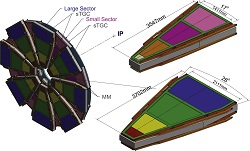
The Hadron Physics Laboratory of the High Energy Physics Division (HEPD) was formed in 2001.
The staff of laboratory participates in the
ATLAS (A Toroidal Large hadron collider ApparatuS)
experiment at Large Hadron Collider (
LHC)
at the European Center for Nuclear Research - (
CERN).

The ATLAS experiment is aimed to research in a topical areas of modern elementary particle physics -
from precision measurements of the Standard Model (
SM) parameters to the search for the "new physics", beyond the SM (supersymmetry, dark matter, extra dimensions, quantum black holes, etc.).
More than 3000 physicists from 38 countries take part in the ATLAS experiment.

At the stage of creating the ATLAS detector, the laboratory staff participated in the development and assembly of a Transition Radiation Tracker
(Transition Radiation Tracker,
TRT).
The TRT is designed to register tracks of charged particles, measure their momenta and electrons identification.
The 50 modules for the end part of the TRT were assembled in PNPI, each of them contain 4 layers of drift tubes, 150000 pieces in total.
For more details about the participation of HEPD HFL in the construction of the TRT detector, see the
Presentation,
Poster-1,
article
and
figures (
fig.-1
and
fig.-2)

Currently, Hadron Physics Laboratory staff are involved in the modernization of the forward part of muon spectrometer (New Small Wheels NSW) of ATLAS detector.
At the moment, the staff of the laboratory is working on the strip Thin Gap Chambers
(
sTGC) construction.
For more details see the section
"Current projects"
and in
Poster-2 .
For the second phase of modernization of the ATLAS detector (2024-2026), the laboratory staff participates in the construction of a cooling system for a new semiconductor tracker.
(
Inner Tracker, ITk).
The laboratory staff take an active participation in the physics program of the ATLAS experiment: both in the study of Standard model properties and in the searches for a "new physics".
A number of important physical results were obtained by HPL physisist.
See details in
Poster-3 .
The current research projects in which the laboratory staff are involved are:
- Study of the top quark properties -
(TOP_intro.pdf),
(solovyev_top_quark.pdf)
and (TOP_spin_seminar_v1_fin.pdf);
- Searches for the Dark Matter - see (DM_intro.pdf),
(DarkMatter_PNPI_Feb_2017.pdf);
- The search for a new particles from extended Higgs sector (new neutral heavy
Higgs boson).
(pdf);
- Search the invisible Higgs boson decay, including its decay to dark matter particles.
(pdf);
- Study of Bose-Einstein correlation.
(pdf);
- Measurement of the transverse momentum distribution of Drell–Yan lepton pairs in proton–proton collisions. (pdf)
For more details see the section
"Current projects"
and
collections of articles
which include the main results of the scientific activities of the HEPD.